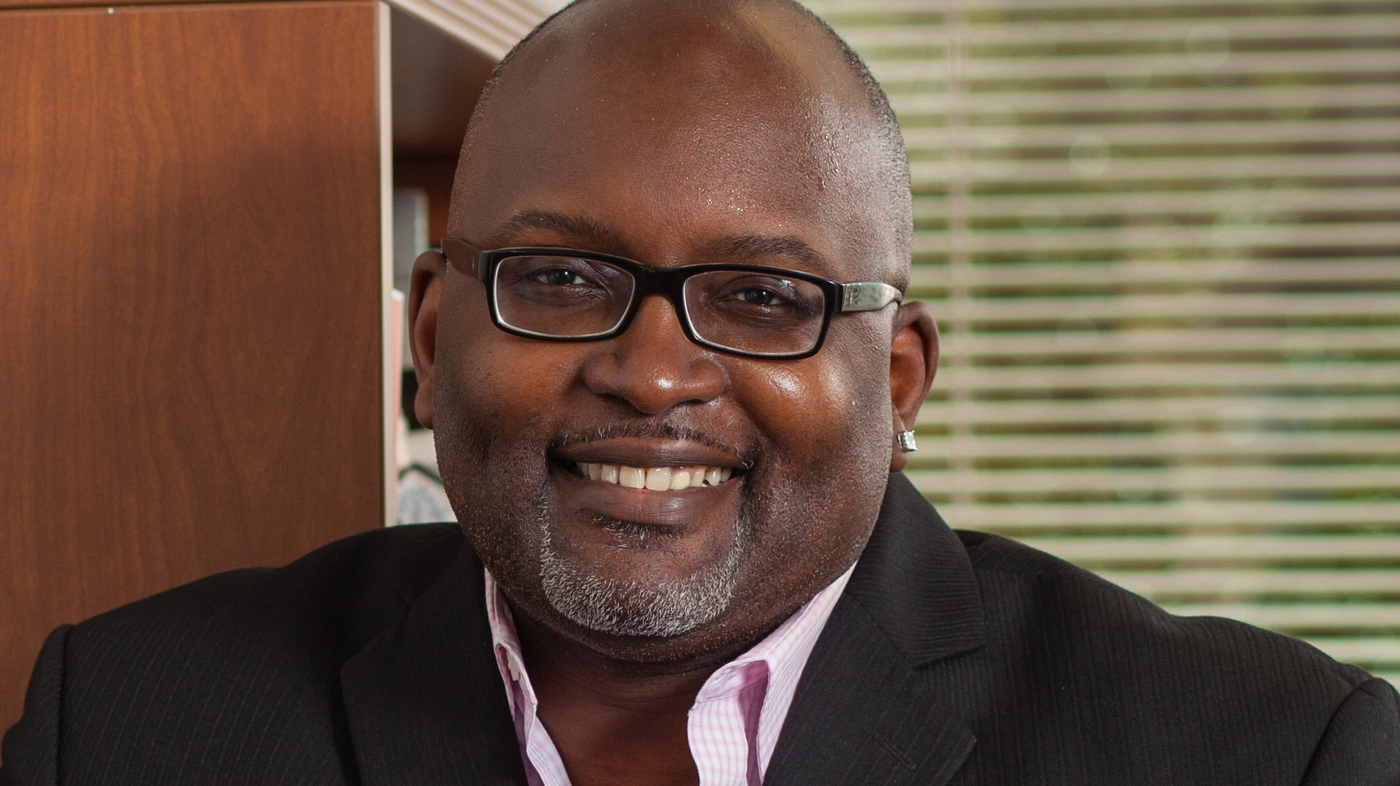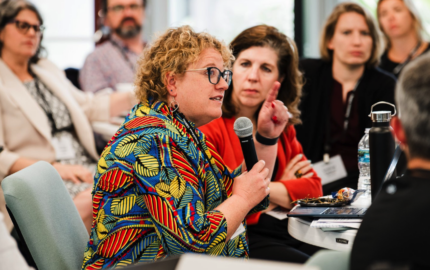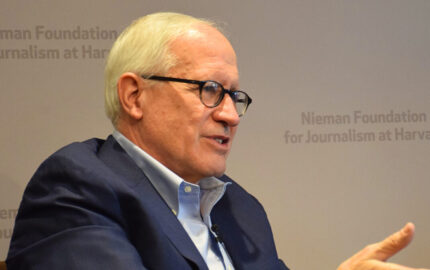As a media critic, author, and educator, Eric Deggans is one of the nation’s foremost commentators on matters relating to race and the media. NPR’s TV critic — the first person to hold that position full-time — and a contributing media analyst for MSNBC/NBC News, Deggans also teaches a Duke University journalism course largely based on his 2012 book “Race-Baiter: How the Media Wields Dangerous Words to Divide a Nation.” With a title inspired by Bill O’Reilly calling Deggans “one of the biggest race-baiters in the country,” the book is a powerful examination of how certain news outlets and personalities perpetuate racism and prejudice in their work.
Before joining NPR in 2013, Deggans worked for nearly two decades as a critic and in other roles at the Tampa Bay Times. He worked at the Asbury Park Press in New Jersey as well as both the Pittsburgh Post-Gazette and Pittsburgh Press. His writing has appeared in numerous outlets, including The Washington Post, Salon, and CNN.com.
Speaking with Nieman Fellows in November, Deggans discussed why race should not be treated episodically by the media, the media’s reliance on the police’s version of what happened, and more. Edited excerpts:
On how the media has done covering racially-charged issues in 2020 — and how to keep the conversations going
Eric Deggans: As always, it’s a mixed report card. After George Floyd died and then Breonna Taylor’s death became a big issue — and Rayshard Brooks in Atlanta, who got killed in a Wendy’s parking lot, that happened around the same time — we started having these international protests around police brutality and civil rights. Of course, media organizations everywhere jumped into it and started reporting.
I feel like a lot of good work always happens when these things happen. Our challenge is to keep the conversation going when that moment passes. Right now, people are fatigued, they’re tired of coronavirus lockdowns, they’re worn out by the election.
I sense that there is not as much tolerance for talking about systemic racism and civil rights and racial issues now as there was at the beginning of the summer or throughout the summer. But now is when we need to keep the conversation going.
That’s the challenge for media — to figure out ways to bring this conversation effectively to an audience that often doesn’t want to talk about or hear about it during moments when it is not a headline‑generating front-page issue.
I’ve always said, and I wrote about this in Nieman Reports years ago, that if you watch a local TV news broadcast or even a national network news broadcast, there’s a moment where they tell you how the stock market did. That’s a way to give your report card on the economic health of the nation.
Whether or not that makes any sense anymore, that’s the tradition. That’s what you do [with race]. Right after that in the local TV news, you have the sports report, you have the weather. We need to find a way to make race own a similar space in newscasts and in our news coverage.
Every day we need to be finding ways to interrogate this issue and interrogate it in a way that people view it as regular coverage. It’s not controversial to do a story on business. It’s not controversial to tell people how the home team did, but for some reason when you do stories on race, it’s expected to be this blockbuster thing and very controversial. We need to get past that.
On what young journalists can teach us
I’m very proud of young journalists, because I think young journalists have forced this industry to face its systemic racism in a way that even my generation didn’t.
Each generation pulls us a little closer to the goal. My generation did a lot, but these young journalists rising up and refusing to let the editor of The Philadelphia Inquirer go about his business, refusing to allow the op‑ed page of The New York Times to continue the craziness they were doing over there, the false equivalency.
It is time for news managers to step up and take action and if they won’t, younger staffers will put their careers on the line and make sure they do. I find that amazing and gratifying. I’ve been trying to help the young folks at NPR as much as I can find their voice too because they’re also pulling us.
As somebody from my generation who’s worked in newspapers, I come to NPR in 2013 and 22 percent of our newsroom is non‑white. I have never worked at a newspaper where the diversity is anywhere near that high. When I went to work at the Asbury Park Press, there were three Black men who worked in the central office in Neptune who were not janitors. My boss was one of those, entertainment editor Isaiah Poole.
That’s the environment that I came from. To go to NPR and to be in a place where our top newscasts at the time, “All Things Considered” and “Morning Edition” were both led by Black women managers and 22 percent diversity, I felt like wow, this is how it’s supposed to be.
The younger folks come in and they’re like, it’s not parity. We don’t have diversity levels that are equal with the population. We got to keep pushing. I have learned from that.
It’s important for those of us who’ve been in the business for a while to not just shrug off what younger journalists are saying, particularly when it comes to diversity. Don’t just assume “They’re getting mad over nothing” or “They need to learn how to get with the program” or “I can’t believe they’re complaining about things that we learned to live with.”
We should not have learned to live with the things that we learned to live with. That’s the lesson we should learn from them.
On hiring teams, not one journalist, to cover race
Anybody who’s been in the business for a while knows that if they commit salaries to it, then you know they’re serious. When I see that ABC News and CBS News have developed staffs that are race and culture units, where more than one person is tasked with covering this issue on an ongoing basis, then that heartens me.
If you’re taking specific people, and you’re hiring them, and you’re paying them to generate those stories, then you’re not going to do that and let those stories sit on a shelf. That’s the kind of commitment that you need to see.
That is encouraging to me, because I think it’s much harder to say “no” to a team, and it’s much harder to justify all those salaries if you’re not running their stories. That’s a good start. I hope that we see more of it.
One of the things that has always astounded me about newspapers is that they have a very focused sense of who their audience is and so have not done a great job of reaching out to who their audience is not. There are so many newspapers that send so many signals in their coverage about who is part of the accepted group, who is considered a valued part of their audience, and who is not.
That’s another thing that needs to be broken down, because if you’re a person of color and you pick up a newspaper, and you see a story on Halloween costumes. You look and you see that every model in the shoot is a white person. You go, “Well, what are they telling me about how I fit, when it’s something that has nothing to do with race or culture? It’s just Halloween costumes.”
It’s about constantly breaking that stuff down and teaching news outlets that as your audience shrinks, you can’t take anybody in the community for granted. Some news outlets have a lot of work to do to convince segments of the population that they will represent them fairly, and that they deserve their business.
On issues of race being treated episodically in the media
If you teach an audience that race coverage is episodic, and that when the stories do come, they’re about huge controversies that are filled with conflict, then you’re teaching them that every story that comes along that’s about race is to be judged that way.
I would do stories where race was a secondary or tertiary part of the story. I did a piece once about Jimmy Fallon taking over “The Tonight Show.” I noted in the third or fourth paragraph from the end of the story, that in a way, he set up the show so that he’s living this millennial fantasy, where he’s got all these cool Black guys in the backing band co‑signing everything that he’s doing.
[I had some reader say, “Why are you always writing about race?” I was like, “That’s a paragraph toward the end of a huge story.” The story wasn’t about race, but I didn’t ignore the racial element of the story. I made sure to mention it.
That’s an example of people in the audience being so used to race being such a controversial, and contentious, and focused part of stories that they’re not quite sure what to do when a story comes along, where race is presented as something that’s secondary or tertiary and part of helping you understand the situation, but not the main subject or the main focus of the story.
That’s why I think sometimes, stories about race can be viewed as contentious by the audience, because that’s the only time they may see some news outlets ever talk about race substantively, is when they’re exploring stories that are contentious.
If you don’t have a newsroom that is willing to interrogate how race may be part of something, even inside their own building, then you’re going to get coverage that echoes that blinkered world view.
On how the media perpetuates racism through crime coverage
My first job on the school newspaper, at Indiana University, was the cops beat. I would go to the police department. I would look through their logbook to see who had gotten arrested the night before. I would take down all the information. The most interesting arrests, we would do as briefs in the newspaper.
Now, they were based on arrest reports. A cop arrests somebody, writes down his or her version of what happened, and then we print it in the newspaper like that’s what happened. Almost every newspaper did it that way.
We have all these conventions that persist in modern journalism where we take law enforcement’s word for what happened, and we publish it like it’s fact. Then, once we do that, good luck convincing the community that the cops were wrong. We also create a situation where our credibility is tied in with the police’s credibility.
After years and years of taking their arrest reports and throwing them in the newspaper like they’re fact, if it turns out that they’ve been lying, now we have to admit that we’ve published these lies for years.
It’s not just that you have this parade of Black and brown faces being portrayed as criminals. You have this parade of stories that says that whatever law enforcement says happened was the truth of what happened. The only time we contradict that is when it’s a big enough story that we devote actual reporting resources to look into what happened.



